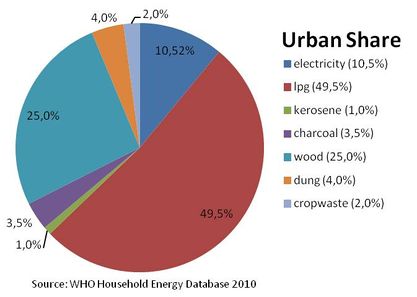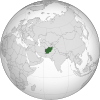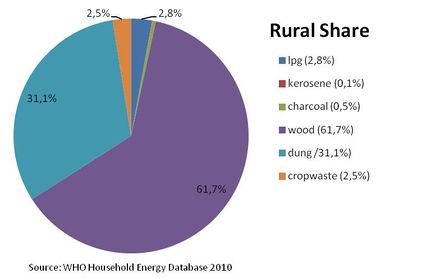Afghanistan Energy Situation
Overview
| Afghanistan | |||
| |
| ||
|
Capital |
Kabul (34° 32′ 0″ N, 69° 10′ 0″ E) | ||
|
Official language(s) |
Dari (Persian) and Pashto | ||
|
Government |
Islamic republic | ||
|
President |
Hamid Karzai | ||
|
Prime Minister |
| ||
|
Total area |
647,500 km2 | ||
|
Population [1] |
29.8 million | ||
|
Rural-Population |
23 million (77%) | ||
|
Urban-Population |
6.8 million (23%) | ||
|
Population Density |
43 Persons per km² | ||
|
Average Household Size |
11.4 | ||
|
GDP (nominal) |
$15.608 billion | ||
|
GDP per Capita |
$517 | ||
|
Currency |
Afghani (AFN) | ||
|
Time Zone |
CET (UTC+04:30) | ||
|
Calling Code |
+93 | ||
Environmental Situation
Climate
Arid to semiarid; cold winters and hot summers
Mean temperature (°C min/max): 4.3/19.6 [2]
Resources
Natural gas, petroleum, coal [1]
Forest Situation
Land area covered by forest: 1.3%
Forest annual rate of change: 0% [3]
Socioeconomical Situation
Income Sources
Agriculture: 79%, industry: 6%, services: 16%
Energy Situation
Type your text here
Energy Supply
Electricity
Sources
Hydropower 63,7% and fossil fuels 35,3%
Stability
Type your text here
Energy Consumption
Type your text here
National Level
Electricity
Household Level
Percentage of energy types used for cooking in rural areas [4]

Percentage of energy types used for cooking in rural areas. [4]
Percentage of Population Using Solid Fuels
National: >95% [5]
Solid Fuel Use Impact on Health
Total annual deaths attributable to solid fuel use: 23900 persons
Percentage of national burden of diseases attributable to solid fuel use: 4.9% [6]
Access Rate
Electrification Rate
Electrification rate in households:[7]
National: 23%, urban: 74%, rural: 3%
Renewable Energies
Application
Type your text here
Potentials
Solar Energy
Type your text here
Wind Energy
Type your text here
Biomass
Type your text here
Biogas
Type your text here
Hydro Power
Type your text here
Other renewable Sources
Type your text here
Key problems of the energy sector
Type your text here
Policy framework, laws and regulations
Type your text here
General Energy policy, Energy strategy
Type your text here
Important Laws and regulations
Type your text here
Specific strategies (Biomass, renewable energies, rural electrification, energy access strategy etc.)
Type your text here
Institutional set up in the energy sector
Type your text here
Governmental institutions Private sector (enterprises, NGOs)
Type your text here
Activities of other donors, activities of NGOs
Type your text here
Existing projects
Type your text here
Publications
Type your text here
External links
References
- ↑ 1.0 1.1 CIA - The World Factbook: https://www.cia.gov/library/publications/the-world-factbook/geos/af.html
- ↑ UN Data (2008): http://data.un.org/CountryProfile.aspx?crName=Afghanistan
- ↑ FAO (2011) The State of the World's Forest
- ↑ 4.0 4.1 WHO 2010: WHO Household Energy Database
- ↑ WHO (2006): Fuels for Life
- ↑ WHO (2006): Fuels for Life
- ↑ The National Risk and Vulnerability Assessment 2005, Kabul, Afghanistan. Cited in WHO (2009) The Energy Access Situation in developing Countries






















